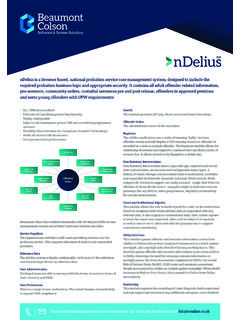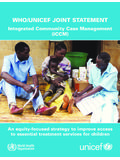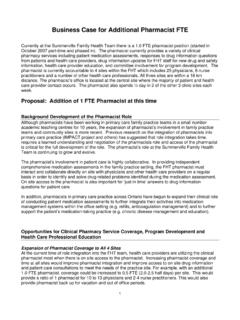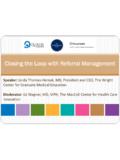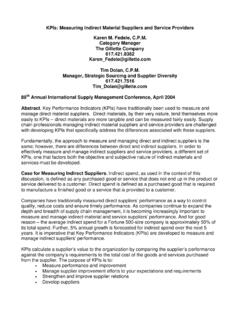Transcription of Population health management - EY - United States
1 A strategy for success in the new age of accountable careContinued pressures to reduce health care costs, improve quality and implement value-based payment programs are moving providers and payers toward closer alignment. Population health management (PHM) is a key collaborative strategy for both groups to enhance care delivery, control the cost of care and work together to better the health of their concept of PHM is not a new one. health plans have been engaging in PHM activities for many years stratifying group populations by risk, identifying high-cost conditions and enlisting members for participation in disease management programs. However, now payers are collaborating with providers and integrating PHM principles and technologies in an unprecedented approach to curtailing costs and delivering value. This health Industry Post looks at the concept and drivers of PHM, as well as the capabilities needed to support and advance it in a new age of accountable health management health Industry PostNews and analysis of current issues affecting health care providers and payers2| health Industry Post: News and analysis of current issues affecting health care providers and payersWhat is PHM: defining the parameters PHM is a model for helping providers and payers assess the populations they serve across the continuum of care.
2 It involves the stratification of patients into well-defined risk groups and the creation of differential care strategies based on each group s needs. Its goal is to reduce costs by preventing those who are well from becoming ill and improving quality of life and enhancing health outcomes for those who have developed one or more chronic condition. Populations vary by age, gender, income, ethnicity, geography and health status. As the industry continues to transition from volume-based to value-based health care, PHM represents a fertile ground for incentives around reducing risk, driving appropriate utilization and improving outcomes (see Exhibit 1). And for most organizations, the logical starting point for PHM will be chronic diseases such as diabetes, heart disease and focuses on:1. Identifying and supporting the sickest patients More than 133 million Americans, or about 45% of the Population , have at least one chronic condition, which accounts for more than 75% of national health care spending.
3 Identifying these high-risk patients early and implementing proactive disease and case management programs will enable providers and payers to cut down on inappropriate spending and improve patient care. Analysts note that by 2023, improving prevention and disease management could save the US over $1 trillion in direct and indirect costs on seven of the most common chronic diseases (see Exhibit 2, page 3).2. Minimizing or preventing the progression of diseaseAccording to the Institute of Medicine s Crossing the Quality Chasm report, about 50% of Americans with chronic illnesses are not receiving recommended care. Providers and payers will need to work together to verify physicians are abiding by medical best practices and patients are adhering to their treatment plans. Through robust data analysis, gaps in care can be identified, preventive measures taken and risks Promoting a culture of wellnessCentral to an effective PHM model are informed and involved patients who participate in setting their own goals for wellness.
4 Hence, providers and payers will need to design targeted, long-term strategies that drive patient engagement and promote healthier behaviors. Moreover, the necessary infrastructure must be in place to gather patient information not only at the site of care, but also remotely, as trends indicate that health care will be delivered in the lowest-cost and most efficient environments, such as the patient s home. An effective PHM program will keep patients as healthy as possible, which will in turn maximize the value of coordinated care and minimize the need for high-cost interventions such as emergency department visits and hospitalizations. Exhibit 1. Effective Population care: a three-part equationRightpatientTargeting members through rules and models that provide high sensitivity and specificityRightwayProviding patients with holistic, seamless and coordinated care, on the patient s termsRighttimeDelivering care when it is most effective in producing the best outcomes, with a focus on modifying risk Source: Ernst & Young, 2013.
5 3 2014 Ernst & Young LLP |PHM drivers: understanding the shiftAs employers seek better care for their employees, government initiatives have also created a need for the health care industry to collaborate and integrate in new ways. The concept of PHM is embedded in many provisions of the Patient Protection and Affordable Care Act (ACA), providing incentives for prevention, quality and safety, and better care coordination. Exhibit 3 on page 4 summarizes the ACA provisions that are driving PHM activity. Since HIEs began accepting open enrollment in October 2013, the pressure on participating plans is expected to continue to intensify. Effective care management will require health plans to better identify and stratify populations served. To do this, health plans will limit their typical use of predictive modeling to set premiums, and instead use these models more strategically to manage risk after customer the quest for outcomes-based and resource-effective care management , health plans will need to triage members into care intervention buckets of varying intensity using such levers as member risk profiles, consumer preferences and attitudes, and performance guarantees.
6 To manage populations and new risk pools effectively, payers will also require enhanced clinical capabilities. They will need to focus on evaluating demand capacity of primary care networks, as well as developing trusted relationships with accountable care providers. Exhibit 2. Cost savings associated with improved chronic disease and conditions prevention and management (in billions)$0$300$600$900$1,200 Lost economic output (indirect)Treatment expenditures (direct)92243709712314619224529736542850 85896657618539351,0261,123 06 08 10 12 14 16 18 20 2220232004 This study evaluated the financial burden of seven of the most common chronic diseases and conditions: cancer, diabetes, heart disease, hypertension, mental disorders, pulmonary conditions and stroke. The Milken InstituteCentral to an effective PHM model are informed and involved patients who participate in setting their own goals for technology (IT) as the catalyst: turning data into actionPHM requires robust business analytics and data management to identify and analyze populations, apply appropriate care interventions and track results.
7 For maximum value, organizations will need to capture and meaningfully use information, including: Analyzing historical data Assessing current performance Identifying predictive markers Determining appropriate resource allocation Incentivizing care providers in dealing with sicker populations4| health Industry Post: News and analysis of current issues affecting health care providers and payersExhibit 3. ACA as a driver of PHMACA provisionPHM can help health care organizations to:1. Reduce readmission rates. The ACA eliminates payments for unnecessary readmissions, making hospitals financially accountable for patients up to 30 days after they leave the hospital. Monitor activities across the care continuum to promptly identify care gaps and better manage care transitions. 2. Conduct community health needs assessments. Nonprofit hospitals must conduct a comprehensive community health needs assessment every 3 years and report their activities to the Internal Revenue Service.
8 These assessments must include information on how the hospital plans to meet identified needs and why any such needs are not being with community partners in creating initiatives that address defined community health needs, such as smoking cessation and child obesity programs. 3. Provide coverage for prevention and wellness services. The law requires health plans to cover preventive, wellness and chronic illness management services with zero copays. It also expands coverage for a wide range of prevention and wellness services, increases incentives for employers that establish wellness programs, and provides coverage for wellness visits under Medicare and Medicaid. Create strategies that engage patients in their own care, including health promotion programs that increase awareness of health risks associated with certain behaviors and Develop medical home-and community-based care transition grant programs.
9 These initiatives encourage partnerships between hospitals and other community organizations to connect the care relationships among providers (hospitals, physicians, long-term care, rehabilitation, alternative care providers), payers and community organizations to provide the Population the appropriate level of Create health insurance exchanges. The ACA creates state-based HIEs administered by a governmental agency or non-profit organization, through which individuals and small businesses with up to 100 employees can buy qualified coverage. In 2014 and beyond, Americans who work for small businesses or obtain their coverage in the individual health insurance market will likely do so through health services operations and processes with innovative analytics and technologies, enabling provider -payer collaborations that capitalize on HIE opportunities. Source: The ACA; Ernst & Young analysis, 2014 Ernst & Young LLP |Furthermore, data must be captured in a way that facilitates structured decision-making.
10 It must be able to simultaneously support care interventions and ensure the right steps are taken by physicians at the right time. provider -payer collaboration In developing an effective PHM program, providers and payers bring to the table different, yet complementary, strengths. Payers have typically invested in collecting and analyzing useful data on their customers, while providers bring to bear rich clinical data and experience. Integrating the claims data and analytical capabilities owned by payers with the real-time information and established relationships developed by providers can yield more actionable information and customized care interventions. health insurers who formerly relied on individual claims are now looking across their entire membership to specifically define the appropriate level of financial risk and drive the right kinds of interventions. Many are sharing their predictive analytics findings with providers to assist them in identifying which patients could benefit most from care interventions.











